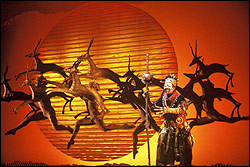![]() The Lion King
The Lion King
Paramount Theatre; ends Sun., Jan. 16
Before rhapsodizing about what breathtaking stagecraft Julie Taymor and her fellow artists have imagined for this adaptation of the Disney cartoon, it’s important to mark the immensity of the accomplishment by noting the dubious text they had to work with in the first place. There’s a reason this Broadway blockbuster took home all the major creative Tony Awards in 1998 save for the book by Roger Allers and Irene Mecchi and the music and lyrics by Elton John and Tim Rice—they’re second-rate at best, lousy pop blather at worst. For all its transcendent visual splendor, this is still a show featuring a pair of lions making doe eyes at each other while dancing African cacti celebrate the union to the strains of “Can You Feel the Love Tonight.”
You forgive such Magic Kingdom treacle whenever Taymor and company harmonically converge to transform the meager material into theatrical nirvana. The show opens with the “Circle of Life” ceremony honoring the birth of cub Simba, an event that brings all form of animal life across the stage and down the aisles of the Paramount. I can only guess how thrillingly heady this must be for any children in the house, but it brought roars of delight from the big kids on opening night. The most exhilarating quality about the spectacle is how much it rewards the capacity of your own imagination to fill in the blanks. Unlike the plummeting chandelier in Phantom of the Opera or the helicopter in Miss Saigon, The Lion King‘s big moments are inescapably the result of a childlike willingness to suspend your disbelief: The lumbering elephant, the stately giraffes, the cascade of prancing antelope are all fantastic amalgams of costume and intricate puppetry (both of which the remarkable Taymor had a hand in creating, along with fellow mask maestro Michael Curry). The artful expanse of African savanna that Richard Hudson’s scenic design envisions and the majestic glow with which lighting designer Donald Holder illuminates it are products of a united vision set on proving the glories of an art form.
The story’s sometimes tiresome grandiosity means only that the comic performances have a chance to really make an impression because they break the solemnity. Brandon Louis makes a gorgeous, rich-voiced Simba, who will eventually reclaim the animal throne lost when his father, Mufasa (Rufus Bonds Jr.), is murdered by the evil Scar (Larry Yando), but it’s the cartoon antics of meerkat Timon (Adam Hunter) or the persnickety bird Zazu (Derek Hasenstab) that are more memorable. Doesn’t matter—if you’re watching The Lion King for the movie’s self-important parable, you’re at the wrong show. Taymor and her crew are out to remind us that this is singular theater we’re experiencing, not a stage-bound attempt at replicating a film’s success. STEVE WIECKING
Flux
Consolidated Works; ends Sat., Dec. 11
In the best spirit of postmodernism, SOM’s Luke Allen and Allison Van Dyck make references everywhere in this new work, from peep shows to last summer’s Henry Art Gallery exhibit about Trisha Brown’s equipment pieces. Binding together these various elements is Van Dyck’s choreography, which alternates between movement done with deliberate care and elegant abandon. With dancers performing throughout the ConWorks space—defined, enhanced, or obscured by Allen’s video installations—the audience moves from vignette to vignette, sometimes making choices between simultaneous parts of the work.
Flux is full of perceptual tricks. Two dancers “walk” along the wall, suspended from the ceiling by ropes, but they’re actually stepping in place, their progress simulated by the video footage flowing across them. Another pair of dancers hugs the wall behind a translucent screen, extending arms and legs into the light so their giant shadow looks like rapidly growing seaweed. In one of the most successful parts of the work, the dancers perform with video images of themselves projected behind them. Allen, who is a composer as well as a video artist, has altered the timing of the film versions, in some cases slowing them down to the point that their dynamics shift radically; watching the live dancers match timing with their projected doppelgängers points up the lack of gravity in the two-dimensional versions. But as Allen bends time for the film dancers, he also creates a new rhythmic structure for their movement sequences, a visual counterpoint to an aural experience.
By putting Flux in a gallery environment, Van Dyck and Allen seem to be commenting on the role of the audience as voyeur. Although there are lines on the floor to divide “dancing” space from “watching” space, the viewers are much closer than in a standard theater environment. And by keeping one dancer in a “room” off the main space, supplied with furniture and framed by a hole in the wall, the act of looking becomes illicit—climbing over furniture and moving the same vase over and over again, she seems oblivious to the audience in a way the other performers are not. At the end of the program, when the rest of the cast climbs over the threshold to join her and then disappear from view, we realize with a shock that she’s left us, the watchers, behind. SANDRA KURTZ




